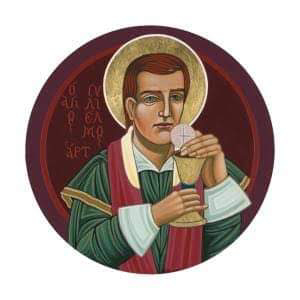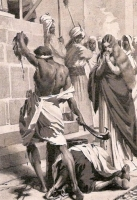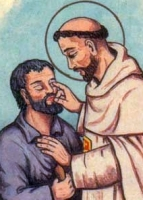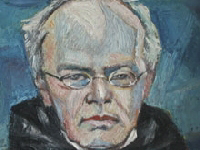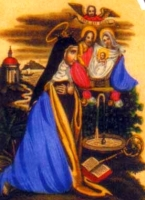St. Raymond of Fitero
Born unknown
Died 1163 AD
Ciruelos, Toledo, Spain
Venerated in Roman Catholic Church
Canonized cult approved in 1719[1]
Feast March 15;[1] February 1
Cistercian abbot and founder of the Order of Calatrava, also called Ramon Sierra. Born in Aragon, Spain, he served as a canon at Tarazona Cathedral and then joined the Cistercians at Scala Dei Monastery in France. He was sent to Spain to establish and serve as abbot of the Fitero Abbey in Navarre, a post which brought him into the forefront of the struggle between Christian Spain and the Moors. Thus, when the Moors were on the verge of attacking the Toledo outpost of Calatrava in 1158, Raymond convinced King Sancho HI of Castile to aid his call for an army to march to the city's defense. Assisted by Diego Velasquez, a one time knight who was then a humble monk, Raymond enlisted the aid of the archbishop of Toledo and created a vast host of Christian soldiers. The Moors failed to attack, but Raymond suggested that the knights be formed into the military order of the Knights of Calatrava. The members accepted the Benedictine rule and soon distinguished themselves as one of the most ardent forces advancing the cause of the Reconquista. The cult of Raymond as a saint was approved in 1719.
Saint Clement Mary Hofbauer
புனிதர் கிளெமன்ட் மேரி ஹொஃப்பௌவர்
மறைபணியாளர், மத குரு, வியன்னாவின் அப்போஸ்தலர்:
பிறப்பு: டிசம்பர் 26, 1751
டப்விட்ஸ், ஸ்நோஜ்மோ மாவட்டம், போஹெமியா அரசு, ஹப்ஸ்பர்க் பேரரசு
இறப்பு: மார்ச் 15, 1820
வியன்னா, ஆஸ்டிரியன் பேரரசு
ஏற்கும் சமயம்:
ரோமன் கத்தோலிக்க திருச்சபை
(அதிதூய மீட்பர் சபை மற்றும் வியன்னா உயர்மறை மாவட்டம்)
முக்திபேறு பட்டம்: ஜனவரி 29, 1888
திருத்தந்தை பதின்மூன்றாம் லியோ
புனிதர் பட்டம்: மே 20, 1909
திருத்தந்தை பத்தாம் பயஸ்
நினைவுத் திருநாள்: மார்ச் 16
பாதுகாவல்:
வியன்னா, ஆஸ்திரியா
புனிதர் கிளெமன்ட் மேரி ஹொஃப்பௌவர், ஒரு "மொராவியன் துறவியும்" (Moravian Hermit) பின்னர், "மீட்பர் சபையின்" (Redemptorist Congregation) மத குருவும் ஆவார். இவர் தமது சபையை இத்தாலியின் "ஆல்ப்ஸ்" மலைகளின் வடக்கே நிறுவினார். ஐரோப்பாவின் கொந்தளிப்பான வறுமையின் கோரப்பிடியில் ஆயிரக்கணக்கான மக்கள் பலியான காலகட்டத்தில், இவர் தமது வாழ்நாள் முழுவதையும் ஏழைகளின் சேவையில் அர்ப்பணித்தார். போலிஷ் (Polish people) மக்களின் சேவையில் தம்மை ஈடுபடுத்திய இவர், அங்கிருந்து ஆஸ்திரியா நாட்டுக்கு நாடுகடத்தப்படும்வரை போலிஷ் மக்களுக்கு சேவை புரிந்தார். “வியன்னாவின்” (Vienna) இணை பாதுகாவலரான இவர், தமது அளப்பற்ற தன்னலமற்ற சேவைகளுக்காக "வியன்னாவின் அப்போஸ்தலர்" (Apostle of Vienna) என்று அழைக்கப்பட்டார்.
"ஜோஹன்னஸ் ஹொஃப்பௌவர்" (Johannes Hofbauer) எனும் இயற்பெயர் கொண்ட இவர், புனிதர் ஸ்தேவானின் (Saint Stephen) நினைவுத் திருநாளான 1751ம் ஆண்டு, டிசம்பர் மாதம், 26ம் நாளன்றும், "மரியா ஸ்டீர்" (Maria Steer) மற்றும் “பவுல் ஹொஃப்பௌவர்" (Paul Hofbauer) ஆகிய பெற்றோருக்கு பிறந்த பன்னிரண்டு குழந்தைகளில் ஒன்பதாவது குழந்தையாகப் பிறந்தார். கிளமென்ட்டுக்கு ஆறு வயதாகையில் இவரது தந்தை மரித்தார். ஏழை விதவைத் தாயார் இவர்களை வளர்க்க கஷ்டப்பட்டார். குரு மாணவராக சேர அல்லது மத சபையொன்றில் இணைய கிடைத்த சிறு வாய்ப்பைப் பயன்படுத்தி, இலத்தீன் மொழி கற்க தொடங்கினார். அவரது உள்ளூர் பங்கின் பங்குத்தந்தையே அவருக்கு கற்பித்தார். கிளமென்ட்டின் குருத்துவ வாழ்வின் நெடிய பயணம் தொடங்கியது. இவருக்கு பதினான்கு வயதாகையில், இவருக்கு இலத்தீன் மொழி கற்பித்த பங்குத்தந்தையின் திடீர் மரணம் காரணமாக, சட்டென இவரது படிப்பு நின்றுபோனது. புதிதாக வந்த பங்குத்தந்தைக்கு, இவருக்கு கற்பிப்பதற்கான நேரம் கிடைக்கவில்லை.
தொடர்ந்து குருத்துவம் கற்க கையில் பணம் இல்லாத நிலையில், ஏதாவது ஒரு கைத்தொழிலோ, வியாபாரமோ கற்க வேண்டிய அவசியத்திலிருந்த கிளமென்ட், ஒரு துறவு மடத்தின் ரொட்டி முதலானவை செய்து விற்கும் பணியகம் (Bakery) ஒன்றில் பயிற்சியாளராக சேர்ந்தார். துறவு மடமென்பதால் அங்கேயே உள்ள இலத்தீன் பள்ளியின் வகுப்புகளுக்குச் சென்று கற்றுக்கொள்ள அனுமதிக்கப்பட்டார். ஆனால், சிறிது காலத்தில் அத்துறவு மடத்தின் மடாதிபதியின் மரணத்தின் பின்னர், கிளமென்ட் துறவு வாழ்க்கைக்கு முயற்சித்தார். ஆனால், “பேரரசர் இரண்டாம் ஜோசப்” (Emperor Joseph II) “ஹப்ஸ்பர்க்” (Habsburg Empire) பேரரசிலுள்ள அனைத்து ஆசிரமங்களை ஒழித்தார். இதன் காரணமாக கிளமென்ட் மீண்டும் வியன்னா திரும்பி ரொட்டித் தொழிலில் இணைந்தார்.
மழைக்காலத்தின் ஒருநாள், புனித ஸ்தேவான் பேராலயத்தில் (Cathedral of St. Stephen), திருப்பலியின் பின்னர் மழையில் காத்திருந்த இரண்டு பெண்களுக்காக வண்டி ஒன்றை அழைத்து வந்தார் கிளமென்ட். அவருடன் அப்பெண்கள் நடத்திய சிறு சம்பாசனையில், வறுமையின் காரணமாக அவரால் குரு கல்வி கற்க இயலவில்லை என்பதனை அறிந்துகொண்டனர். தாராள மனம் கொண்ட அப்பெண்களிருவரும் குரு கல்வி கற்க கிளமென்ட்டுக்கும் அவருடைய நண்பரான "தடேயஸ்" (Thaddeus) என்பவருக்கும் உதவுவதாக கூறினர்.
மகிழ்ச்சியுடன் ரோம் நகர் சென்ற நண்பர்கள் இருவரும் புனிதர் அல்ஃபோன்சஸ் லிகொரியின் (Saint Alphonsus Liguori) "மீட்பர் சபையினரால்" (Redemptorist Congregation) ஈர்க்கப்பட்டனர். 1785ம் ஆண்டு, இவ்விரு இளைஞர்களும் குருத்துவ அருட்பொழிவு பெற்றனர்.
புதிதாக குருத்துவம் பெற்ற இருவரும் வியன்னாவுக்கு அனுப்பப்பட்டனர். ஆனால், அங்கிருந்த மதச் சிக்கல்களால் அவர்கள் அங்கிருந்து கிளம்பி, போலந்தின் "வார்சாவ்" (Warsaw, Poland) சென்றனர். அங்கே அவர்கள் இயேசு சபையினர் ஒடுக்கப்பட்டதால், குருக்கள் இல்லாது விடப்பட்ட ஜெர்மன் மொழி பேசும் எண்ணற்ற கத்தோலிக்கர்களை காண நேர்ந்தது. ஆரம்பத்தில் மிகவும் வறுமையிலேயே வாழ நேர்ந்த அவர்களால் வெளியிடங்களிலேயே மறை போதனை செய்ய இயன்றது. இறுதியில், அவர்களுக்கு புனித "பென்னோ" (St. Benno) தேவாலயம் கொடுக்கப்பட்டது. பின்னர் சுமார் ஒன்பது வருடங்கள் வரை அவர்கள் தினமும் ஐந்து முறை மறைபோதனை நிகழ்த்தினர். மூன்று மறைபோதனைகள் போலிஷ் மொழியிலும் இரண்டு மறைபோதனைகள் ஜெர்மன் மொழியிலும் நிகழ்த்தினர். எண்ணற்ற பிற இன மக்களை கத்தோலிக்க விசுவாசத்துக்கு மனம் மாற்றினர். அவர்கள் ஏழைகளுக்கான சமூக சேவைகளிலும் சுறுசுறுப்பாக இயங்கினர். அனாதைகளுக்கான இல்லம் ஒன்றினை நிறுவினர். ஆண்களுக்கான பள்ளி ஒன்றினையும் நிறுவி நடத்தினர்.
மேலும் பலரை சபைக்கு ஈர்த்த இவர்கள் போலந்து (Poland), ஜெர்மனி (Germany) மற்றும் ஸ்விட்ஸர்லாந்து (Switzerland) ஆகிய நாடுகளுக்கு மறை பணியாளர்களை அனுப்பினர். ஆனாலும், அப்போதிருந்த மத, அரசியல் பதற்ற சூழ்நிலைகளால் இவர்களது நிறுவனங்கள் அனைத்தும் இறுதியில் கைவிடப்பட்டன. இருபது வருட கடின உழைப்பின் பின்னர் கிளமென்ட் கைது செய்யப்பட்டு சிறை செய்யப்பட்டார். பின்னர் அங்கிருந்து நாடு கடத்தப்பட்டார்.
மீண்டுமொரு கைதின் பின்னரே அவரால் வியன்னா சென்றடைய முடிந்தது. அங்கேயே பன்னிரண்டு வருடங்கள் தமது வாழ்க்கையின் இறுதி கால பணி புரிந்தார். ஏழை பணக்காரன் என்ற வித்தியாசம் பார்க்காமல் பாவ மன்னிப்பு வழங்கினார். நோயுற்றோரை காணச் சென்றார். அதிகார வர்க்கத்தினருக்கு ஆலோசகராக இருந்தார். தமது தூய்மையை நகரின் அனைவருக்கும் பகிர்ந்தார். அவர் மிகவும் நேசித்த அவரது நகரில் ஒரு கத்தோலிக்க கல்லூரியை ஸ்தாபித்ததுவே அவர் செய்த சீரிய பணிகளில் சிகரமாய் அமைந்தது. விரைவிலேயே அவர் "வியன்னாவின் அப்போஸ்தலர்" (The Apostle of Vienna) என்றழைக்கப்பட்டார்.
துன்புறுத்தல்கள் அவரையும் தொடர்ந்தன. அதிகாரத்திலிருந்த சிலரால் அவரின் மறை போதனைகளை சில காலம் வரை நிறுத்தி வைக்க இயன்றது. அவரை அகற்றிவிட உயர் பதவி வகித்தவர்களால் ஒரு முயற்சி கூட நடந்தது. ஆனால் அவரது தூய்மையும் புகழுமே அவரை இரட்சித்ததுடன், "மீட்பர் சபையினரின்" (Redemptorist Congregation) வளர்ச்சிக்கு தூண்டுகோலாக இருந்தது. அவரது மரணம் சம்பவித்த 1820ம் வருடம், கிளமென்ட்டின் பெருமுயற்சியால் "மீட்பர் சபை", "வடக்கு ஆல்ப்ஸ்" (North of the Alps) பகுதியில் ஸ்திரமாக நிறுவப்பட்டது.
Also known as
• Apostle of Vienna
• Clemens Mary Hofbauer
• Johannes Hofbauer
• John Dvorák
• Klemens Maria
• Second Founder of the Redemptorists
Profile
Ninth child of a butcher who changed the family name from the Moravian Dvorák to the Germanic Hofbauer. His father died when Clement was six years old. The young man felt a call to the priesthood, but his family was too poor to afford his education. Apprentice and journeyman baker at Premonstratensian monastery at Bruck, Germany. Hermit.
When hermitages were abolished by Emperor Joseph II, Clement worked as a baker in Vienna, Austria. Hermit in Italy with Peter Kunzmann, taking the name Clement. Made three pilgrimages to Rome. During the third, he joined the Redemptorists at San Giuliano, adding the name Marie. He met some sponsors following a Mass, and they agreed to pay for his education. Studied at the University of Vienna, and at Rome. Ordained in 1785, and assigned to Vienna.
Missionary to Warsaw, Poland with several companions from 1786 to 1808, working with the poor, building schools and orphanages; the brothers preached five sermons a day. Spiritual teacher of Venerable Joseph Passerat. With Father Thaddeus Hubl, he introduced the Congregation of the Most Holy Redeemer to Poland. From there he sent Redemptorist missionaries to Germany and Switzerland. Clement and his companions were imprisoned in 1808 when Napoleon suppressed religious orders, then expelled to Austria.
Noted preacher and spiritual director in Vienna. Chaplain and spiritual director of an Ursuline convent. Founded a Catholic college in Vienna. Worked with young men, and helped revitalize German religious life. Worked against the establishment of a German national Church. Worked against Josephinism which sought secular control of the Church and clergy.
Born
26 December 1751 at Tasswitz, Moravia (in the modern Czech Republic) as John Dvorák
Died
15 March 1820 at Vienna, Austria of natural causes
Canonized
20 May 1909 by Pope Pius X
Blessed Jan Adalbert Balicki
Also known as
• John Balicki
• Giovanni Balicki
Profile
Born to a poor but pious family. Attended twelve years of school in Rzeszow, Poland with teachers who taught a love of Polish culture. Entered the seminary at Przemysl, Poland in September 1888. Ordained on 20 July 1892. Assistant pastor of Polna, Poland where he was noted as a gifted preacher and man of prayer. Studied at the Pontifical Gregorian University from 1893 to 1897, concentrating on Saint Thomas Aquinas, spending his evenings in prayer, his free time visiting the shrines of the saints. He came to believe that science could also lead a man to God.
Professor of dogmatic theology at the seminary in Przemysl in 1897. Prefect of studies for three years. Reluctant vice-rector of the seminary in 1927; rector in 1928. He considered the spiritual formation of priests his most important mission, studying reports carefully, and praying for help before presenting candidates to the bishop. Spiritual director of Blessed Ladislaus Findysz.
In 1934 his failing health forced him to resign from the seminary posts, but he lived at the seminary, hearing confessions and working as a favourite spiritual director to students. In 1939 when Przemysl was divided between the warring German and Soviet forces, Father Jan stayed in the Soviet sector, hoping to keep the seminary running; soon, however, he was forced to move from the seminary to the bishop's residence where he stayed even after the war. In his last years his health failed more and more as his tuberculosis spread. Jan was noted for his gentle discernment of the people who entered his confessional, and his devotion to prayer as a way to know the heart of God.
Father Jan wrote a study of mystical prayer that listed four degrees:
• prayer of quiet
• prayer of simple union
• ecstatic union
• perfect union
He gave a list of the seven steps for progress in the spiritual life -
• serious approach to life
• readiness to be critical of self
• unshakable confidence in prayer
• joy of spirit
• love for suffering
• praise of divine mercy
• continuous self amendment
Born
25 January 1869 in Staromiescie, Poland
Died
15 March 1948 of pneumonia and tuberculosis in Przemysl, Poland
Beatified
18 August 2002 by Pope John Paul II at Krakow, Poland
Blessed Artemide Zatti
Profile
One of three sons born to Albino Vecchi and Luigi Zatti. His was a poor family, and the boy had to drop out of school at age nine to work for a wealthy neighbor. The family eventually immigrated to Bahia Blanca, Argentina to find work, arriving in Buenos Aires on 9 February 1897. There Artemide worked in a tile factory, and attended a local parochial school run by the Salesians. He felt drawn to the Salesians, and at age 20 entered their seminary, Casa di Bernal.
Artemide contracted tuberculosis while caring for a young Salesian priest with the disease, a man who died from it in 1902. He was sent to San Josè Hospital for what little treatment there was in that day, but with little hope. With his friend and unofficial doctor, Father Evarisio Garrone, Artemide prayed for the intervention of Our Lady, Help of Christians, offering to dedicate his life to the care of the sick; the young Salesian was miraculously and completely healed.
He kept his promise. He worked in the San Jose pharmacy, and learned about hospital management from Father Garrone. Upon his mentor's death, Artemide took charge of the hospital, and what time he could spare from his administrative duty was spent caring for patients. Today the hospital is named in his honour.
Born
12 October 1880 at Boretto, Reggio Emilia, in northern Italy
Died
• 15 March 1951 of cancer at Bahia Blanca, Argentina
• relics interred in the Salesian chapel at Viedma, Argentina
Beatified
14 April 2002 by Pope John Paul II
Saint Louise de Marillac
புனிதர் லுயீஸ் டி மரில்லாக்
மனைவி, அன்னை, விதவை, நிறுவனர், சமூக சேவகர்:
பிறப்பு: ஆகஸ்ட் 12, 1591
லி மியக்ஸ், ஒய்ஸ், ஃபிரான்ஸ்
இறப்பு: மார்ச் 15, 1660 (வயது 68)
பாரிஸ், ஃபிரான்ஸ்
ஏற்கும் சமயம்:
ரோமன் கத்தோலிக்க திருச்சபை
அருளாளர் பட்டம்: மே 9, 1920
திருத்தந்தை 15ம் பெனடிக்ட்
புனிதர் பட்டம்: மார்ச் 11, 1934
திருத்தந்தை 11ம் பயஸ்
முக்கிய திருத்தலங்கள்:
அன்னையின் அற்புத பதக்க சிற்றாலயம், ரியூ டு பக், பாரிஸ், ஃபிரான்ஸ்
நினைவுத் திருவிழா: மார்ச் 15
பாதுகாவல்:
பெற்றோரை இழந்தோர்
நோயாளிகள் (Sick People), கைம்பெண்கள்
சமூக சேவகர்கள்
ஏமாற்றமடைந்த குழந்தைகள்
மத சபையினரால் நிராகரிக்கப்பட்ட மக்கள்
"புனிதர் லுயீஸ் டி க்ராஸ்" (Louise Le Gras) என்றும் அழைக்கப்படும் புனிதர் லுயீஸ் டி மரில்லாக் (Louise de Marillac), புனிதர் வின்சென்ட் தே பவுலோடு (Saint Vincent de Paul) இணைந்து "பிறரன்பின் புதல்வியர் துறவற சபையை" (Daughters of Charity) நிறுவியவரும், கத்தோலிக்க திருச்சபையின் புனிதரும் ஆவார்.
தொடக்க காலம்:
லுயீஸ் டி மரில்லாக், ஃபிரான்ஸ் நாட்டின் பாரிஸ் நகரில் 1591ம் ஆண்டு, ஆகஸ்ட் மாதம், 12ம் தேதி பிறந்தார். சிறு வயதிலேயே இவர் பெற்றோரை இழந்தார். இருந்தாலும் நல்ல முறையில் வளர்க்கப்பட்டார். பெரிய துறவற மடம் ஒன்றில் கல்வி பயின்றார். இதனால் இவருக்கு துறவற வாழ்வில் ஆர்வம் ஏற்பட்டது. பாரிஸ் நகரிலுள்ள "கப்புச்சின் அருட்சகோதரிகள்" (Capuchin nuns) என்ற துறவற சபையில் சேர இவர் விண்ணப்பித்தார். இவரது விண்ணப்பம் மறுக்கப்பட்டது. லூயீஸ் மனமுடைந்து போனார். எனவே, 22 வயதான இவரை இல்லற வாழ்வில் ஈடுபடுமாறு குடும்பத்தினர் அறிவுறுத்தினர்.
1613ம் ஆண்டு, ஃபெப்ரவரி மாதம், 5ம் தேதி, “ஆன்டனி லீ க்ராஸ்” (Antoine Le Gras) என்பவருடன் "புனித ஜெர்வைஸ்" (Church of St. Gervaise) தேவாலயத்தில் இவருக்கு திருமணம் நடந்தது. மரில்லாக் மகிழ்ச்சியுடன் குடும்பம் நடத்தினார். இவர்களுக்கு மைக்கேல் (Michel) என்ற குழந்தையும் பிறந்தது. இந்த நிலையில் இவரது கணவர் கடுமையாக நோய்வாய்ப்பட்டார். மரில்லாக், தனது கணவரை அன்புடன் கவனித்துக்கொண்டார். ஆனாலும் கடவுளுக்காக துறவறம் மேற்கொள்ள வேண்டும் என்ற எண்ணம் இவரது மனதில் தொடர்ந்து நீடித்தது. இரண்டு ஆண்டுகள் வேதனைக்கு பின்பு இவரது கணவர் மரணம் அடைந்தார்.
துறவற சபை:
அந்த வேளையில் லுயீஸ் டி மரில்லாக், புனிதர் வின்சென்ட் தெ பவுலை சந்திக்க நேரிட்டது. அதன்பின் ஏழைகளுக்கும் தேவையில் இருப்பவர்களுக்கும் உதவி செய்யும் விதத்தில், இவர் துறவற வாழ்வை மேற்கொண்டார். புனிதர் வின்சென்ட் தெ பவுலுடன் இணைந்து, பிறரன்பின் புதல்வியர் என்ற துறவற சபையைத் தோற்றுவித்தார்.
இவருடன் சேர்ந்து உழைத்த துறவற சபை அருட்கன்னியர்கள், பாவிகளை மனந்திருப்புவதிலும், ஏழைகளுக்கு உதவி செய்வதிலும் ஆர்வமுடன் உழைத்தனர். நோயாளிகளை கவனிக்க மருத்துவமனைகளும், ஆதரவற்றோரை கவனிக்க முதியோர் இல்லங்களும் இச்சபை சார்பில் அமைக்கப்பட்டன.
மரில்லாக் மக்களுக்கு செய்த சேவையை, இயேசு கிறிஸ்துவுக்கு செய்த சேவையாக எண்ணினார். ஏழைகளிலும், கைவிடப்பட்டோரிலும் கடவுளைக் கண்டார். சிறப்பாக இவரது சபையினர் ஏழைப் பெண்களுக்கு உறைவிடம் அளித்து, உணவு கொடுத்து பாதுகாத்து வந்தனர். போரில் காயம் அடைந்த வீரர்களுக்கும் மருத்துவ சேவை செய்தனர்.
இயேசு கிறிஸ்துவின் பெயரால் மக்களுக்கு சேவைகள் செய்து வந்த லுயீஸ் டி மரில்லாக் 1660ம் ஆண்டு, மார்ச் மாதம், 15ம் தேதி, மரணமடைந்தார். அவரது மரணத்தின்போது, அவர் நிறுவிய சபையின் நாற்பதுக்கும் மேற்பட்ட கிளைகள் ஃபிரான்ஸ் நாடு முழுதும் பரவியிருந்தது. அவர் மரித்த ஆறாம் மாதத்திலேயே புனிதர் வின்சென்ட் தே பவுலும் (Saint Vincent de Paul) மரணமடைந்தார்.
1960ம் ஆண்டு, “திருத்தந்தை 23ம் ஜான்” (Pope John XXIII) இவரை கிறிஸ்தவ சமூக சேவகர்களின் பாதுகாவலராக அறிவித்தார். புனிதர் லுயீஸ் டி மரில்லாக்கின் அழியாத உடல், பாரிஸ் நகரில் இவர் வாழ்ந்த துறவற சபையின் சிற்றாலயத்தில் இன்றளவும் பாதுகாக்கப்பட்டு வருகிறது
Also known as
• Louise de Marillac Le Gras
• Luisa
Profile
Though she considered a religious vocation from an early age, her ill health kept any house from taking her. She married Antony LeGras, an official to the queen, in 1611. Widowed in 1625. Spiritual student of Saint Vincent de Paul. With Saint Vincent, she founded the Daughters of Charity in 1642, receiving Vatican approval in 1655. Founded the Sisters of Charity, took her vows in the order, and served as its superior until her death. Spiritual guide for groups of lay women.
Born
12 August 1591 at Meux, France
Died
• 15 March 1660 at Paris, France of natural causes
• body incorrupt
Canonized
11 March 1934 by Pope Pius XI
Blessed Anthony of Milan
Also known as
• Antonio of Milano
• Anthony Cantoni
• Anthony Cantoni of Milan
Profile
One of three Franciscans assigned to Armenia with a mission to improve the conditions of Christians there, and to bring the faith to any Muslims who were open. In Arzenga, Armenia, on the first Friday in Lent, the group stood in the street and preached Jesus to the people going to prayers. To prevent violence in the street, the local leader ordered a stop to the preaching. The missionaries ignored the order and returned the following Friday. Local Muslims threatened to kill the street preachers, and the council of elders agreed. On the third Friday, the missionaries returned, were arrested, and dragged to the city's public square. A local Muslim man tried to defend them and spoke against violence, but he was killed on the spot. The mob then turned on the Franciscans, attacking with swords, dismembering the men before finally killing them. Martyr.
Died
• beheaded on 15 March 1314 at Arzenga, Armenia
• their severed arms and legs were hung on the city walls as a warning, their bodies dragged to the fields to be left for wild animals
• body parts collected and buried by a local priest and his parishioners
Blessed Francis of Fermo
Also known as
• Francesco de Fermo
• Francis of Petrioli
• Frans av Fermo
Profile
One of three Franciscans assigned to Armenia with a mission to improve the conditions of Christians there, and to bring the faith to any Muslims who were open. In Arzenga, Armenia, on the first Friday in Lent, the group stood in the street and preached Jesus to the people going to prayers. To prevent violence in the street, the local leader ordered a stop to the preaching. The missionaries ignored the order and returned the following Friday. Local Muslims threatened to kill the street preachers, and the council of elders agreed. On the third Friday, the missionaries returned, were arrested, and dragged to the city's public square. A local Muslim man tried to defend them and spoke against violence, but he was killed on the spot. The mob then turned on the Franciscans, attacking with swords, dismembering the men before finally killing them. Martyr.
Died
• beheaded on 15 March 1314 at Arzenga, Armenia
• their severed arms and legs were hung on the city walls as a warning, their bodies dragged to the fields to be left for wild animals
• body parts collected and buried by a local priest and his parishioners
Blessed Monaldus of Ancona
Also known as
Monaldo
Additional Memorial
28 April (translation of relics)
Profile
One of three Franciscans assigned to Armenia with a mission to improve the conditions of Christians there, and to bring the faith to any Muslims who were open. In Arzenga, Armenia, on the first Friday in Lent, the group stood in the street and preached Jesus to the people going to prayers. To prevent violence in the street, the local leader ordered a stop to the preaching. The missionaries ignored the order and returned the following Friday. Local Muslims threatened to kill the street preachers, and the council of elders agreed. On the third Friday, the missionaries returned, were arrested, and dragged to the city's public square. A local Muslim man tried to defend them and spoke against violence, but he was killed on the spot. The mob then turned on the Franciscans, attacking with swords, dismembering the men before finally killing them. Martyr.
Died
• beheaded on 15 March 1314 at Arzenga, Armenia
• their severed arms and legs were hung on the city walls as a warning, their bodies dragged to the fields to be left for wild animals
• body parts collected and buried by a local priest and his parishioners
Pope Saint Zachary
Also known as
Zacharias
Profile
Son of Polichronius, but little else is known of his early life. Deacon. Advisor to Pope Gregory III. 91st pope. First pope after Saint Gregory the Great to not seek imperial confirmation on his election. Negotiated peace between the Lombards and Greek empire. Restored the Lateran palace and many churches around Rome. Encourged the missionary work of Saint Boniface, and appointed Saint Abel as archbishop of Rheims, France. When Venetian slavers bought slaves at Rome to sell to Saracens in Africa, Zachary bought them all so that Christians should not become the property of heathens. Translated the Dialogues of Gregory the Great into Greek. Many of his actions among the royal powers of the day continued to echo for centuries.
Born
• at Calabria, Italy
• Greek ancestry
Papal Ascension
5 December 741
Died
• 22 March 752 of natural causes
• buried at Saint Peter's Basilica, Rome, Italy
Blessed William Hart
அருளாளர்_வில்லியம் ஹார்ட்
மார்ச் 15
இவர் (#BlWilliamHart) இங்கிலாந்து நாட்டைச் சார்ந்தவர்.
ஆக்ஸ்போர்டு பல்கலைக்கழகம் போன்ற பல இடங்களில் கல்வி கற்ற இவர், 1581 ஆம் ஆண்டு குருவாக அருள்பொழிவு செய்யப்பட்டுத் தன் சொந்த நாட்டிற்கே திரும்பி வந்து, யோர்க் என்ற இடத்தில் இருந்த சிறையில், கத்தோலிக்கக் கிறிஸ்தவக் கைதிகளைச் சந்தித்துத் தேற்றினார்.
இதை இவருக்கு நெருக்கமாக இருந்த ஒருவர் அரசாங்க அதிகாரியிடம் காட்டிக் கொடுக்க, 1583 ஆம் ஆண்டு இவர் தூக்கிலிடப்பட்டார்.
Additional Memorials
• 29 October as one of the Martyrs of Douai
• 1 December as one of the Martyrs of Oxford University
Profile
Raised Protestant. Educated at Lincoln College, Oxford. Convert to Catholicism. Studied for the priesthood at Douai, Rheims, and Rome, Italy. Ordained in 1581, he returned to England to minister to covert Catholics. Betrayed by an apostate in the house of Saint Margaret Clitherow. Martyr.
Born
1558 at Wells, England
Died
martyred on 15 March 1583 at York, North Yorkshire, England
Beatified
29 December 1886 by Pope Leo XIII (cultus confirmed)
Saint Aristobulus of Britannia
Also known as
• Aghios, Arwystli, Aristibule
• Aristobulus Senex
• Aristibulus the Old
• Apostle to Britain
Additional Memorial
• 4 January (feast of the Seventy Disciples)
• 31 October (feast of the assistants of Saint Andrew)
Profile
One of the 70 disciples sent out to preach Christianity at the beginning of the Church. Missionary to the British Isles. Mentioned by Saint Paul the Apostle in the Epistle to the Romans ("Greet those who are of the household of Aristobulus."). Martyr.
Blessed Pío Conde y Conde
Profile
Baptized at the age of one day. Member of the Salesians of Don Bosco, beginning his novitiate in Sarrià-Barcelona, Spain, and making his profession on 3 February 1906. Priest. Worked in colleges in the Spanish cities of Sarrià, Madrid, Valencia, Béjar, Salamanca and Santander. Martyred in the Spanish Civil War.
Born
4 January 1887 in Portela-Allariz, Orense, Spain
Died
15 March 1937 in Madrid, Spain
Beatified
28 October 2007 by Pope John Paul II
Saint Menignus of Parium
Also known as
Menigno of Pario
Profile
Married layman. fuller and cloth dyer. Tortured, his fingers hacked off, and executed in the persecutions of Decius for tearing down an edict suppressing the faith. Martyr.
Died
• beheaded c.250 in the Greek city of Parium in the Hellespont (in modern Turkey)
• witnesses say they saw his soul leave the mouth of his severed head in the form of a dove
Saint Leocritia of Cordoba
Also known as
Lucretia
Profile
Born to wealthy Moorish parents, Leocritia converted to Christianity; her family drove her out. Saint Eulogius of Cordoba gave her shelter. She entered into religious life, was arrested, scourged, and martyred.
Born
Cordoba, Spain
Died
beheaded on 9 March 859 in Cordoba, Spain
Blessed Walter of Quesnoy
Profile
Premonstratensian canon in Vicogne, France. Abbot of the house in 1212. During his 17 year abbacy he was known for re-invigorating the spiritual lives of his brothers, re-building and expanding the monastery, and collecting the relics of saints.
Born
late 12th century
Died
• 26 September 1229 of natural causes
• interred in the choir of his abbey
Saint Nicander of Alexandria
Profile
Physician noted for his charity, for ministering to and treating people imprisoned for their faith, and giving Christian burial to martyrs who died in the persecutions of Diocletian. Imprisoned, tortured and martyred for his faith and good works.
Born
Egyptian
Died
beheaded in the 4th century in Alexandria, Egypt
Blessed Arnold of Siena
Also known as
Arnaldo
Profile
Studied law in Toulouse, France. Augustinian hermit, taking his vows on 11 July 1494; known for his strict observance of the Rule of his Order.
Died
20 May 1507 of natural causes
Beatified
never officially beatified, but popular devotion began soon after his death
Blessed Ludovico de la Pena
Profile
Mercedarian monk at the convent of Santa Eulalia in Seville, Spain. Miracle worker restoring sight to the blind, hearing to the deaf, and raising the dead to life. Died during a vision of the Blessed Virgin Mary.
Blessed Peter Pasquale
Profile
Mercedarian friar, receiving the habit from Saint Peter Nolasco. First Commander of the San Martino monastery in Perpignan, France. Miracle worker.
Saint Mancius of Evora
Profile
Christian slave bought in Rome, Italy by Jewish traders and taken to Evora, Portugal where he was martyred by his new owners.
Born
5th century Rome, Italy
Died
5th century Evora, Portugal
Saint Eusebius II
Also known as
• Eusebio II
• Eusebius II of Vercelli
Profile
Bishop of Vercelli, Italy in 501.
Died
c.520
Saint Speciosus
Profile
Wealthy land owner at Campania, Italy. He and his brother Gregory became monks, taking the cowl from Saint Benedict at Monte Cassino. Monk at Terracina.
Died
c.555 at Capua, Italy of natural causes
Saint Bodian of Hanvec
Also known as
• Bodianus of Hanvec
• Bozian of Hanvec
Profile
I can find no information on this saint.
Born
6th century Wales
Saint Sisebuto
Also known as
Sisebut
Profile
Monk. Abbot of the Spanish monastery of Cardena.
Died
1086 near Burgos, Castile, Spain of natural causes
Saint Eoghan of Concullen
Profile
Son of Saran of Cloncullen. Monk.
Born
County Tipperary, Ireland
Three Daughters of Eltin
Profile
Listed in several Irish martyrologies, but no details about them have survived.
Saint Vicenta of Coria
Profile
Nun. Martyr.
Died
424 in Coria, Hispania Lusitana (in modern Portugal)
Saint Matrona of Capua
Profile
Nun in Capua, Italy.
Pius Keller
பயஸ் கெல்லர்
பிறப்பு
25 செப்டம்பர் 1825,
பாலிங்ஹவ்சன் Nallinghausen, பவேரியா
இறப்பு
15 மார்ச் 1904,
முனர்ஸ்டாட் Münnerstadt, பவேரியா
இவர் ஓர் விவசாயியின் குடும்பத்தில் பிறந்தார். இவரின் பெற்றோர் இவருக்கு யோஹானஸ் Johannes என்று பெயரிட்டனர். இவர் குருவாக திருநிலைப்படுத்தப்பட்ட சில மாதங்களிலேயே 1849 ஆம் ஆண்டு அகஸ்டின் துறவற இல்லத்திற்குச் சென்றார். இவர் அவ்வில்லத்திற்குச் சென்ற ஒரு சில ஆண்டுகளில் அவ்வில்லத்தின் தலைவராகத் தேர்ந்தெடுக்கப்பட்டார். இவர் தனது 53 ஆம் வயதில் அச்சபையின் மாநிலத் தலைவராகத் தேர்ந்தெடுக்கப்பட்டார். அதன்பிறகு இவர் மீண்டும் முனர்ஷ்டட் திரும்பினார்.
இவர் அங்கு எண்ணிலடங்கா துறவற இல்லங்களைக் கட்டினார். அத்துடன் குருமடங்களையும் நிறுவினார். இவர் ஒப்புரவு அருட்சாதனம் கேட்கும் பணியை எப்போதும் தவறாமல் செய்தார். இவர் தன் வாழ்வின் எல்லாச் சூழலிலும் மிகக் கடுந்தவ வாழ்வை வாழ்ந்தார். இவர் புனித அகஸ்டின் துறவற இல்லத்தின் வாழும் புனிதர் என்றழைக்கப்பட்டார். 1934 ல் ஆண்டு முத்திபேறுபட்டம் அளிப்பதற்கான ஏற்பாடுகள் தொடங்கப்பட்டது. 1960 ஆம் ஆண்டு தயாரிப்பு பணிகள் அனைத்தும் முடிந்ததும் எழுத்தில் வடிவமைத்து அறிக்கைகள் அனைத்தும் உரோமைக்கு அனுப்பப்பட்டுள்ளது. இவரின் உடல் அகஸ்டின் துறவற இல்லத்தில் அமைந்துள்ள கல்லறையில் அடக்கம் செய்யப்பட்டுள்ளது
(30 September 1825 in Ballingshausen, Bavaria, Germany – 15 March 1904 in Münnerstadt, Germany) was an Augustinian friar, a teacher, and a leader who revitalized The Order of Saint Augustine in Germany.
Life and times
Pius Keller was raised in a farm family. His family supported his studies at Münnerstadt and at the University of Würzburg.
Pius entered a diocesan seminary in 1846, and was ordained a Priest in 1849. Within the same year, he became a teacher in Münnerstadt and it wasn't until later that year, Pius became a Novice in the Order of Saint Augustine. For most of his adult life, he was a teacher. He influenced many young students to follow the basic principles of the Faith throughout their lives. The Order gave several positions of responsibility to Pius; he served several terms as Prior local superior in Münnerstadt, and was named Commissary General and Assistant General assistant world leader. It was in 1895 when he was chosen Prior Provincial regional superior of the newly restored Augustinian Province of Germany. Pius Keller reestablished community life and observance of the Rule and ideals of Saint Augustine. Under his leadership, the Order in Germany grew for when entered, the German Province had only two houses and eleven friars; there were nearly one-hundred friars in five monasteries by the year 1900. Pius spoke in his writings of his great love for history and for the Augustinian spiritual heritage. His remains are preserved at the monastery church in Münnerstadt since 1904.
Becoming a saint
The cause for Pius Keller's beatification and canonization began in 1934. However, during World War II, most of the documents pertaining to his cause were destroyed. The process resumed in 1956. It wasn't until 1990, that the Congregation of Saints recognized the validity of his cause. Fernando Rojo Martínez, O.S.A., the Augustinian Postulator of Causes, oversees the progress of the cause today.






